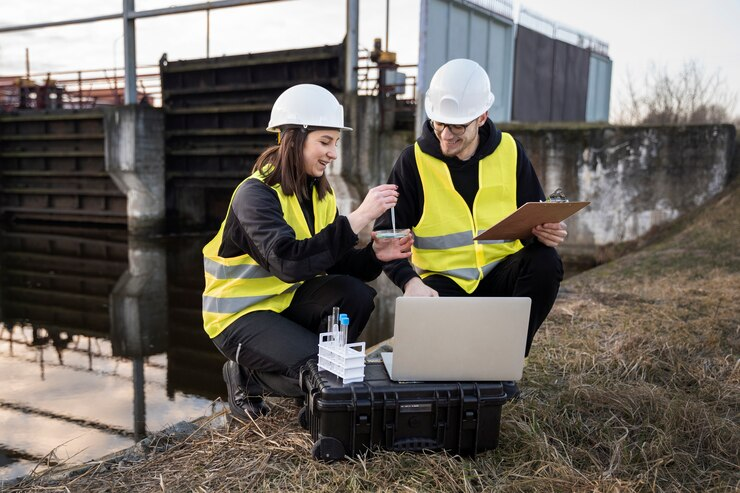What Is Non-Destructive Testing (NDT) | A Detailed Guide
What will you think when we tell you to imagine looking inside a bridge without drilling a hole and peering into a jet engine without taking it apart? You will think that it sounds like making a fool of people. Let me tell you that these things are possible by entering the fascinating world of Non-Destructive Testing.
Think about it as giving your car an X-ray. NDT helps us look more deeply than just the outside, finding hidden cracks or problems that could make driving unsafe. This is essential in many industries, ensuring that airplanes, pipelines, medical devices, and artwork are safe and work well.
Today in this blog post, we will know everything about NDT, such as what it is, where it is used, how it works, its benefits, and many more. So, stay tuned in this blog and read from start to end to know the information that may help you.
What Is Non-Destructive Testing?
So, what exactly is NDT? Imagine being able to inspect the integrity of a structure or material without causing any damage to it. That's the essence of NDT. It's like giving something a thorough check-up without leaving a scratch! In simpler terms, think of it as a detective investigating a crime scene without disturbing any evidence.
Now, you might be wondering why NDT is such a big deal. Well, imagine if you could examine an aircraft's engine without dismantling it or check the quality of a bridge without disrupting traffic. That's the magic of NDT – it allows us to ensure safety and reliability in various industries without causing unnecessary downtime or expenses. The need for NDT (Non-Destructive Testing) solutions in manufacturing factories is expected to grow by an average of 6.2% every year from 2023 to 2033.

Where Is Non-Destructive Testing Used?
NDT is used to check how good parts and machines are before or while we use them. It's like giving them a check-up without breaking them. We use NDT in many industries to ensure things are in good condition and are of good quality. Some industries that use NDT include:
- Aerospace uses NDT to test metal shapes.
- Automotive industries use NDT to check how strong piston heads are.
- NDT is used in manufacturing to see if parts are good enough before making them.
- Medical devices use NDT to test the durability and composition of stents.
- Military and defense use NDT to test bullets and study how they work.
- Power generation also uses NDT to check if there are any problems with welding.
- Waste management uses NDT to find valuable metals in trash.
What Are The 8 Common Non-Destructive Testing Methods?
In NDT and Non-Destructive Evaluation (NDE), different methods are used to gather various kinds of helpful information. Each method needs its own tools, training, and preparation.
Some methods can check the whole volume of an object, while others can only look at its surface. Also, certain NDT methods work better with certain materials. For example, Magnetic Particle NDT only works with materials that can be magnetized.
Here are the 8 most commonly used NDT techniques:
- Visual NDT (VT)
- Ultrasonic NDT (UT)
- Radiography NDT (RT)
- Eddy Current NDT (ET)
- Magnetic Particle NDT (MT)
- Acoustic Emission NDT (AE)
- Dye Penetrant NDT (PT)
- Leak Testing (LT)
What Are The Advantages of Non-Destructive Testing?
NDT offers a plethora of benefits across various industries:
-
Provides Safety Assurance
NDT is like a superpower that lets us find problems in things like metal, machines, and buildings without hurting them. It's like a secret agent searching for clues to keep us safe. When NDT finds a problem early, it stops big disasters from happening, like buildings collapsing or machines breaking down.
-
Enhances Reliability
Non-Destructive Testing (NDT) checks things really carefully without breaking them or stopping them from working. It helps ensure important stuff stays in good shape and does what it's supposed to do for a long time. This is essential in industries like airplanes, oil and gas, manufacturing, and building bridges and roads.
-
Saves Money In The Long Run
Finding problems early with NDT saves money. It means companies don't have to spend as much fixing things later. It also means they don't have to stop working suddenly because something broke. Companies can save money on repairs by fixing issues before they become big problems.
-
Mitigates Environmental Risk
In today's world, it's crucial for businesses to think about how their operations affect the environment. Using old-fashioned testing methods that harm the environment can lead to big problems. NDT is a better option because it doesn't create waste when testing materials. It's essential if you want to avoid these problems and ensure your products are safe and reliable.
-
Ensures Quality Control
NDT helps ensure that everything, from the start of making something to the final product, meets the highest standards. It uses methods that don't damage what they're testing. This way, it catches any mistakes or problems without causing harm.
Conclusion
NDT is like a silent hero that works behind the scenes to keep us safe. It might not get much attention, but it plays a significant role in our lives. Whether it's making sure airplanes are safe to fly or checking that bridges are strong, NDT is always there, quietly doing its job to protect us and our surroundings.
Now that you've learned about the incredible impact of Non-Destructive Testing (NDT) on our safety and infrastructure, it is time to feel it practically. Contact Quality Testing for further details. We are a Special Inspection Agency in NEW York and have been offering services since 1997. Please pay a visit to our website and fill out the contact form.